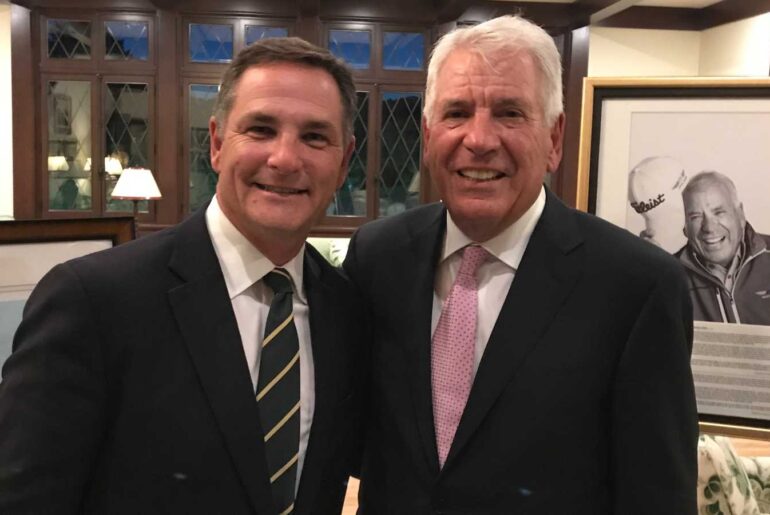Professional golfer Phil Mickelson
(Bloomberg) — One of the most compelling corporate dramas in the US oil industry right now isn’t playing out in the Permian Basin or Alaska’s North Slope but against the unlikely backdrop of tony Santa Barbara, California — with a walk-on part from a famous professional golfer.
Most Read from Bloomberg
Sable Offshore Corp. is trying to revive some former Exxon Mobil Corp. offshore fields that hold hundreds of millions of barrels of crude in a state prone to chronic energy crunches.
That plan is looking increasingly precarious. In recent days, Sable was denied a permit by the Santa Barbara Board of Supervisors, and on Monday the company announced a $250 million stock sale to extend the maturity of more than $600 million in debt. Short sellers have piled in as the shares tumbled to an all-time low, cratering almost 50% last week.
On top of all that, a recent report from Hunterbrook Media alleged Sable executives selectively disclosed information to investors including pro golfer Phil Mickelson, who has been a vocal supporter of the company on social media. Sable has formed a special committee to probe the allegations.
Sable’s woes reflect the challenges inherent in developing US offshore oil production even as President Donald Trump’s administration tries to boost crude output along the nation’s coastline. Despite having refineries ready and willing to take locally sourced crude, South California’s denizens remain fiercely protective of their sandy beaches and mindful of past spills, including one off Santa Barbara a decade ago.
The company’s struggles also represent a major setback for its leader, Chief Executive Officer Jim Flores. The oil-sector veteran who spent much of his three decades in the industry working on offshore projects led an equity issuance for Sable just over five months ago that raised about $295 million from investors.
“It’s about Sable’s management right now,” Claire Brown, founder of hedge fund Aristides Capital LLC, said in an interview. “It’s tough for an institutional investor to throw more capital at a management team they no longer trust.”
Even by the standards of Sable, which has seen its stock rise or fall by at least 10% no fewer than 20 times this year, it’s been an extraordinary several days and the company appears to be at an inflection point.
Distressed debt investors are circling. They’re seeking to purchase portions of the loan Sable incurred to purchase the oil fields and related assets last year, according to people familiar with the matter. Such moves, if done in significant volume, could signal an intent to seize the assets.
A Sable spokesperson didn’t respond to requests for comment.
Meanwhile, Flores, Sable’s largest single investor, saw the value of his stake fall by more than $450 million in less than six months as of the Nov. 6 close of trading, according to Bloomberg calculations.
Those paper losses was stemmed somewhat after Monday’s equity-sale announcement prompted the stock to spike 23% to $6.55 as of 9:55 a.m. in New York, almost one-fifth higher than the sale price for the new stock.
Sable’s California foray began last year when it acquired a cluster of offshore fields known as the Santa Ynez Unit from Exxon. The assets were in a state of suspended animation after a 2015 pipeline leak that threatened wildlife, stained beaches and alarmed regulators.
Sable began the process of restarting oil production in May but part of the pipeline network needed to send crude to refineries remains shuttered because of stiff resistance from regulators, local officials and environmentalists.
Offshore oil and gas platforms near Santa Barbara, California.Photographer: Eric Thayer/Bloomberg
Mickelson, a three-time winner of golf’s Masters Tournament, has lauded Sable’s efforts as a potential boon for Golden State consumers as well as a job creator and source of cleaner crude than some foreign sources. On social media, he’s been an outspoken critic of California’s stringent regulatory approach to oil drilling and pipelines.
“$SOC Sable offshore is a win for EVERYONE including environmentalists!” Mickelson wrote in a Sept. 9 post on X. “It’s obviously a win for investors who could make a huge profit if the company restarts.”
Mickelson didn’t respond to requests for comment through his agent. Exxon, which hasn’t been accused of any wrongdoing or involvement in Sable’s communications with investors, said via a spokesperson that the company doesn’t comment on commercial discussions or market speculation.
The $623 million loan modification tied to the new shares sale would boost the interest rate to 15% a year from 10%, according to a Nov. 3 filing. Once effective, the maturity date would be extended to the earlier of March 31, 2027, or 90 days after the first sale of hydrocarbons from the fields.
Short interest in Sable stock peaked this year in early May at more than 21% of the so-called free float, according to S&P Global data. Then it declined after the company received state permission to perform some pipeline repairs and the stock climbed.
In late June, however, short interest intensified again, reaching more than 17% last week. Aristides was among those that covered most of its short position after the stock price collapsed in the wake of Hunterbrook’s Oct. 31 report, Brown said.
In options markets, traders rushed into bearish puts on the day of the Hunterbrook report and in one case cashed in profits the following Monday and rolled a position to even lower strikes as the stock continued to tank. Toward the middle of last week, trading had turned more to closing out put positions, before an investor on Nov. 7 bought a large number of put options expiring next December betting on a drop below $3.
Although California Governor Gavin Newsom has sought to temper energy policies decried as onerous by the oil industry, his focus has been on drilling in inland regions like Bakersfield. Sable’s offshore vision has been left out of that embrace.
As recently as a month ago, the stock got a brief bump when Flores signaled the company was prepared to use tankers to haul crude from the Santa Ynez fields as an end-run around the pipeline standoff. He also indicated Sable’s plight was on the radar of President Donald Trump’s National Energy Dominance Council.
But the company’s efforts suffered another blow last week, when a packed hearing before the Santa Barbara Board of Supervisors overwhelmingly rejected transferring operating permits to Sable from the previous owner.
“There is something wrong with the strategy of Sable’s leadership,” said board member Steve Lavagnino, who previously opposed quashing the permit transfers. “Without spilling a single drop of oil Sable has managed to push back the reputation of the industry 20 years.”
–With assistance from Dylan Sloan, David Marino, Kate Seaman and Kevin Crowley.
(Updates with opening share price in 12th paragraph.)
Most Read from Bloomberg Businessweek
©2025 Bloomberg L.P.







